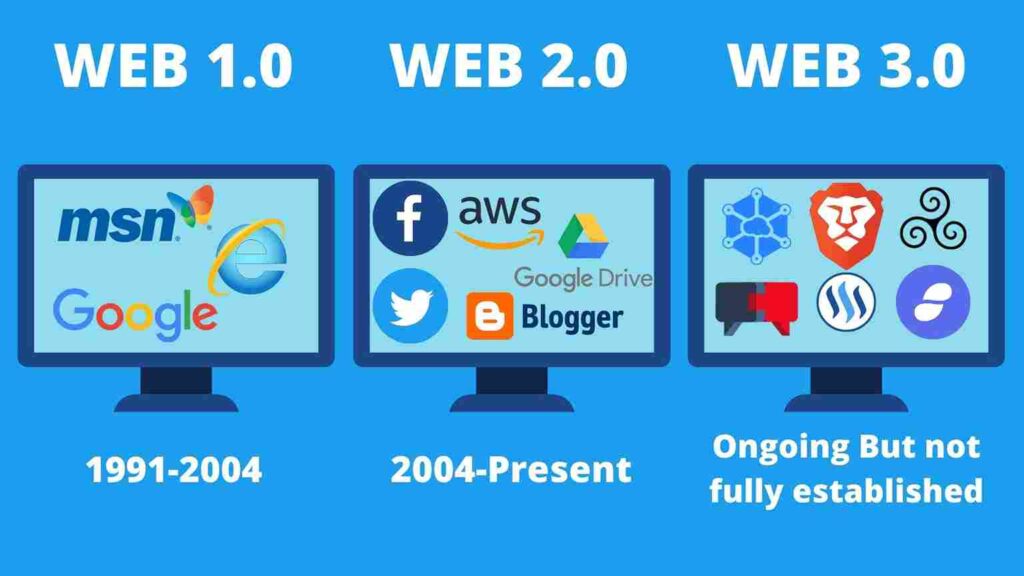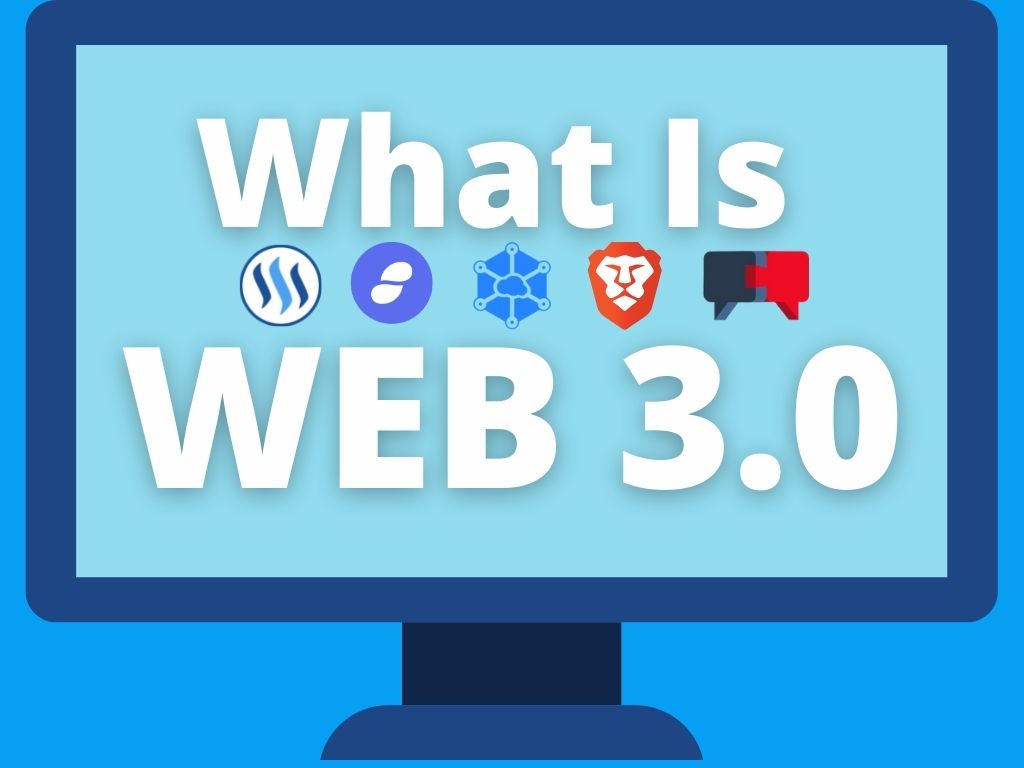Web 3.0 (or simply web3) is the third generation of the Internet that interconnects data in a decentralized way to deliver a secure, faster and more personalized experience to the user.
Web 3.0 is an improvement over the current internet Web 2.0. Technologies like machine learning (ML), artificial intelligence (AI), Big Data, semantic web, decentralized ledger technology (DLT) etc. are used to build the web 3.0 internet. To keep data safe and secure web 3.0 uses blockchain technology.
Web 3.0 will enable us to interact with any individual or machine in the world, without having to pass through fee-charging middlemen. The third version of the internet will have more transparency and boast massive content that will be accessible to all. Additionally, Web 3.0 is believed to be more user-specific, which will ensure data privacy and security while avoiding the risk of hacking.
Evolution of Internet through the years (Web 1.0 to Web 3.0)

Web 1.0 (1991 to 2004)
History of the World Wide Web as it evolved through various technologies and formats. Web 1.0 refers roughly to the period from 1991 to 2004, where most websites were static webpages. Web 1.0 is a read-only web where user can read information written on websites. In web 1.0 content creation was done by a select few and information came mostly from directories.
Key Features of Web 1.0
- Read only content
- Centralized
- Static HTML
- Web Forms
Web 2.0 (2004 to Current Day)
It is based around the idea of “the internet as platform”. It is generally considered to have begun around 2004 and continues to the present day. Web 2.0 is a read-write web where people can read as well as write the content on websites and applications. Web 2.0 makes it possible for user-generated content to be viewed by millions of people around the world virtually. The most popular apps of web 2.0 are Facebook, Airbnb, Uber, Instagram etc.
Key Features of Web 2.0
- Dynamic HTML
- Social Networking
- Blogging
- Community Forms
- Videos and Podcasting
Web 3.0 (Ongoing but not fully established yet)
Web 3.0 is a read-write-interact web (powered by artificial intelligence and machine learning) where people can read, write and interact with content, including 3D graphics, on websites and apps.
It is built upon the core concepts of decentralization, openness, permissionless and greater user utility. Web 3.0 will provide increased data security, scalability and privacy for users.
Key Features of Web 3.0
- Decentralization
- Artificial Intelligence (AI)
- Machine Learning (ML)
- Blockchain
- Semantic Web
- Ubiquity
Defining the key features of Web 3.0
1. Decentralization
This is a core of Web 3.0. In web 2.0 information are stored at a fixed location or centralized server. Web 2 services go down when a server goes down whereas Web 3 does not rely on centralized servers. Web 3.0 service cannot go down as the data is stored in multiple copies on a P2P (peer-to-peer) network. In web 3.0 data is managed via data distribution protocols such as IPFS (Inter Planetary File System).
2. Blockchain
The second most important element of the Web 3 is blockchain. It helps provide verifiability, ownership and economic incentive to the rightful owner of the content. Blockchain technology introduces smart contracts. Smart contracts are just like usual contracts that will let you exchange property, money, shares or anything valuable securely and transparently with a little twist.
In web 3.0 smart contracts stores the ownership and transactions data on the blockchain, making the ownership verifiable and distributing the economic benefit to the content owners.
3. Semantic Web
The Semantic Web is the heart of web3.0. It is an extension of the existing World Wide Web. The goal of the Semantic Web is to make Internet data machine-readable. The World Wide Web is based mainly on documents written in HyperText Markup Language(HTML), a markup convention that is used for coding a body of text interspersed with multimedia objects such as images, videos and interactive forms. The semantic web involves publishing the data in a language, Resource Description Framework (RDF) specifically for data, so that it can be manipulated and combined just as can data files on a local computer.
4. Artificial Intelligence (AI) & Machine Learning(ML)
The major highlight of Web 3.0 is its intelligent capabilities, which is possible through the deployment of Artificial Intelligence (AI) & Machine Learning (ML). Machines have been trained to process data from photos, audios and videos to provide meaningful content that the user is asking for. These capabilities will enable computers to produce faster and more relevant results to the user.
5. Ubiquity
Ubiquity means being or having the capacity to be everywhere, especially at the same time. In other words, omnipresent. In web 3.0 content is accessible by multiple applications, every device is connected to the web, the services can be used everywhere without depending on the connection on computers or smartphones, relying heavily on IoT sensors.
Advantages of Web 3.0
Better Connectivity and Accessibility: In web 3.0, the accessibility of data becomes a lot easier. The communications between devices are smoother with intelligence embedded in systems.
Data Transparency: Due to use of blockchain technology, user will track their data and inspect the code behind the platform.
Uninterrupted Service: In web 3.0 data is stored on multiple nodes to ensure redundancy. So there is no single point of failure due to information stored on multiple locations.
Data Privacy: The most significant advantage of web 3.0 is data encryption to protect the user information from disclosure.
Data/content Ownership: In third generation of internet users will gain complete ownership and control of their information.
Disadvantages of Web 3.0
Requires advanced computer devices: Web 3.0 will be inaccessible to less advanced computer devices.
Complex Functionality: Web 3.0 difficult for newbies to grasp which makes them hesitant to use it.
Web 3.0 websites user interface is friendly and easy to navigate so that any websites based on web 1.0 technology will become obsolete.
Cybercrime & Online Abuse: Due to decentralization web 3.0 is difficult to regulate. This might lead to an increase in cybercrime and online abuse.
Examples of Web 3.0 Applications

1. Brave Browser
Brave is a great example of web 3.0 internet browser. It is a free and open-source web browser developed by Brave Software. It is a privacy-focused browser. Being one of the major browsers in the list heading towards Web 3.0, it recently added blockchain integration and has its cryptocurrency called BAT. It also supports crypto wallets and integrates a P2P file hosting solution.
2. Storj
Storj is crypto-powered cloud storage platforms. It allows any computer running its software to rent unused hard drive space to users looking to store files. Storj relies on software and a network of computers to manage its data storage and it allows users to pay other users on the network to store their files.
3. Essentia.one
Essentia as a personalized operating system, allows us to interact with the new decentralized Internet. It’s like a bridge between the past and the future.
4. Steemit
Steemit is another great example of web 3.0 social network websites. It is powered by the Steem blockchain and STEEM cryptocurrency. It rewards content creators or bloggers with cryptocurrencies for contributing content on the site.
5. Status
Status is a secure messaging app, crypto wallet, and Web3 browser built with state of the art technology. It provides secure communication tool to uphold human rights and empower sovereign communities. Status uses a peer-to-peer model that prevents any 3rd party from controlling users’ data. Status is packaged with go-ethereum, which connects to the Ethereum network.
FAQ
1 What is an Information Security?
Information Security sometimes called InfoSec, act of protecting data & information from unauthorized access, unlawful modification & disruption, disclosure & destruction. Read more
2 What is Anti-virus?
Antivirus is a kind of software used to prevent, scan, detect and delete viruses & other types of malware, such as worms, Trojans, rootkits, adware, spyware from a computer. Read more
3 What is Malware?
Malware is malicious software or program designed to infiltrate a computer system/network and possible damage it without the user’s knowledge or consent. Read more
4 What is Cyber Kill Chain?
The cyber kill chain (also referred to as the cyber-attack chain ) is a way to understand the sequence of events involved in an external attack on an organization’s IT environment Read more
5 What is Public Key Cryptography?
Asymmetric Cryptography also popular as public key cryptography, uses two keys to encrypt data. One key is used for data encryption, while the other key is used for data decryption. Read more
6 Difference between Stream & Block Cipher?
Stream Cipher and Block Cipher, both are the techniques used for encryption and decryption of data, i.e. to convert the plaintext to cipher text and cipher text to plaintext. Read more

